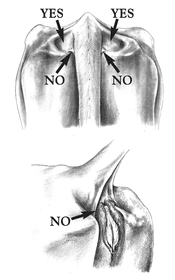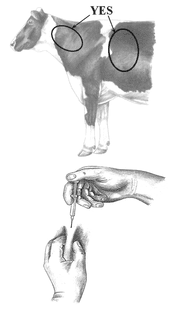Elanco Sells Posilac Business to Brazilian Firm
Feedstuffs Magazine is reporting Elanco Animal Health has sold its Posilac business to Union Agener, one of Brazil’s largest animal health companies.
The sale also includes Posilac’s manufacturing facility in Augusta, Ga. No purchase price has been released. But the sale makes logistical sense, since Posilac is approved for sale in Brazil and 14 Latin and South American countries.
Sales of Posilac in the U.S. have plummeted in recent years as more and more fluid handlers refused to accept milk from BST-treated cows, citing consumer concerns. But it was also a convenient way for handlers and cooperatives to reduce milk production as plants in the Northeast and Midwest over flowed with milk. Today, just pockets of BST-use remain in the U.S.
Elanco announced last fall that it was seeking a buyer for its Posilac business. For a transitional period, Elanco will continue to support sales of Posilac in markets it currently serves.
Elanco seeking to sell Posilac, production facility
Elanco Animal Health is ”exploring strategic options” for Posilac, including seeking a buyer for the recombinant bovine somatotropin (rBST) molecule and its manufacturing facility located in Augusta, Georgia.
Elanco acquired the worldwide rights to Posilac, an injectable supplement designed to increase milk production in dairy cattle, from Monsanto Company in late 2008. While seeking a potential buyer, Elanco will continue to produce and supply Posilac to meet customer demand.
Posilac received U.S. Food and Drug Administration approval in 1994. Despite that approval, the product has faced near-continuous criticism from some consumer advocacy organizations. Increased pressure from those groups has led many dairy processors to refuse to accept milk from cows treated with rBST.
The decision regarding Posilac is independent of the current cyclical downturn in milk prices, but rather represents a long-term strategic shift in Elanco’s dairy portfolio, said Grady Bishop, senior director of global market access for the company. The company did not disclose the number of cows supplemented with Posilac in the U.S. or worldwide, but Bishop said the product remains a business growth opportunity in emerging dairy regions of Latin American and some countries in the Middle East, he said.
The outlook for a continued trend toward larger and fewer U.S. dairy herds also was a factor in the decision, said Roger Cady, Elanco’s global sustainability lead.
The decision will allow the company to bring new products that help farmers protect animal health, enhance animal care and improve profitability, Bishop said.
Dairy animals will remain a focus. The company said it would focus on innovations to address the physical and metabolic changes that can interfere with energy balance and immune function in lactating dairy cows.
“As we look to the future, we’re exploring innovative solutions that work with the animal’s own immune system and other biological mechanisms to help her be more resistant and resilient to stress, disease and other challenges,” said Aaron Schacht, Elanco vice president for research and development.
“There are still many unmet needs dairy farmers face today, and we are focused on optimizing our investment on new dairy innovation to fill the gaps we see,” said Jeff Simmons, president of Elanco. “rBST is an important innovation for dairy farmers around the world, bringing substantial benefits to dairy farmers, consumers and the environment for nearly 25 years. As we move forward, we are seeking to shift to new areas of innovation to bring greater future value to the industry.”
Elanco’s dairy research and product development will target bovine respiratory disease (BRD), mycoplasma and dairy cattle digestive health. The company will also explore whether its Imrestor product shows potential to address other dairy cattle health challenges. Imrestor is approved in the U.S. to treat clinical mastitis in dairy cows and replacement dairy heifers.
Founded in 1954, Elanco is a division of Eli Lilly and Company, with headquarters and research facilities located in Greenfield, Indiana. ![]()
= = = = = = =
https://www.drugs.com/vet/posilac.html
Posilac
This page contains information on Posilac for veterinary use.
The information provided typically includes the following:
- Posilac Indications
- Warnings and cautions for Posilac
- Direction and dosage information for Posilac
Posilac
This treatment applies to the following species:
Manufacturer: Elanco(sometribove zinc suspension)
Description
Sterile, prolonged-release injectable formulation of a recombinant DNA-derived bovine somatotropin analog in single-dose syringes each containing 500 mg of sometribove zinc.
USE: To increase production of marketable milk in healthy lactating dairy cows.
Posilac Caution
Federal law prohibits extra-label use of this drug to enhance food and/or fiber production in animals.
DOSAGE: Inject one syringe of Posilac every 14 days. Start during the 9th or 10th week (57-70 days) after calving and continue until the end of lactation.
ADMINISTRATION: Allow syringes to warm to room temperature (15° to 30° C; 59° to 86° F) before use.
INJECTION TECHNIQUE: Inject Posilac subcutaneously (under the skin). Recommended injection sites are the neck area, behind the shoulder or in the depression on either side of the tailhead (see diagrams below). Alternate between the cow’s left and right side on consecutive injections. Remove surface dirt from the injection site area before injecting. Inject entire contents of the syringe subcutaneously. Do not reuse syringes.
Inject directly into the deepest depressions on either side of the tailhead (marked “Yes”). Avoid the bone, muscles, tendons and ligaments of the tail and the rectal and anal muscles. Do NOT inject into the caudal fold (marked “No”) because this may invalidate USDA tuberculosis testing. Locate the caudal fold by raising the tail.
INJECTION SITES:
Tailhead Depression
 Neck & Behind The Shoulder
Neck & Behind The Shoulder
 Gather skin and inject between skin and muscle layers.
Gather skin and inject between skin and muscle layers.
HUMAN WARNINGS: Avoid prolonged or repeated contact with Posilac with eyes and skin. Posilac is a protein. Frequent skin contact with proteins may produce an allergic reaction in some people. Always wash hands and skin exposed to Posilac with soap and water after handling. Clothing soiled with the product should be laundered before reuse.
– For use in animals only.
– Keep this and all medications out of the reach of children.
Precautions and Side Effects
– Use in lactating dairy cattle only.
– Safety to replacement bulls born in dairy cows injected with Posilac has not been established.
– Avoid injecting within 2 weeks of slaughter to minimize injection site blemishes on carcass.
– Nutritional Management: Cows injected with Posilac increase voluntary feed intake over several weeks following the start of supplementation. This increase occurs sooner for first lactation cows than for second lactation or older cows. The increased feed intake continues during supplementation and may continue through the dry period and the following early lactation. However, cows treated with Posilac tend to maintain lower body condition than untreated cows. This effect is more pronounced for second lactation or older cows.
– Feed diets formulated to meet or exceed the nutritional requirements recommended by the National Research Council. Consider milk yield, stage of lactation, and body condition when making dietary changes. Manage the feeding program to optimize milk yield and to have cows in appropriate body condition, particularly during late lactation and the dry period. Increasing the energy density of diets fed to cows treated with Posilac is normally not required. Avoid sudden dietary changes.
– Reproduction: Cows injected with Posilac may have reduced pregnancy rates and increased days open. Have a comprehensive and ongoing herd reproductive health program in place on your dairy before using Posilac.
– Mastitis: Cows injected with Posilac are at an increased risk for mastitis (visibly abnormal milk) and may have higher somatic cell counts. Have comprehensive mastitis management practices in place on your dairy before using Posilac.
– General Health: Cows injected with Posilac may require more therapeutic drug treatment for mastitis and other health problems. Cows injected with Posilac may experience periods of increased body temperature unrelated to illness. To minimize the effect, take appropriate measures during periods of high environmental temperature to reduce heat stress. Use care to differentiate whether increased body temperature is caused by illness or use of Posilac.
Cows injected with Posilac may have more enlarged hocks and disorders of the foot region.
Posilac treatment may reduce hemoglobin and hematocrit values.
– Injection Site Reactions: A mild temporary swelling of 3-5 cm (1-2 inches) in diameter may occur at the injection site beginning about 3 days after injection and may persist up to 6 weeks following injection. Larger swellings may occur in cows injected in the neck area compared to the behind the shoulder or in the depression on either side of the tailhead. Some cows may experience swellings up to 10cm (4 inches) in diameter that remain permanent but are not associated with animal health problems. However, if permanent blemishes are objectionable to you, stop supplementation of these cows. Also stop using Posilac in cows with injection site swellings that repeatedly open and drain.
– Udder Edema: Posilac is approved for use starting during the 9th or 10th week of lactation. Risk of udder edema may increase if injections start later in lactation.
ADDITIONAL INFORMATION:
– Milk production response during each 14-day injection period is cyclic and will be greatest during the middle of each period.
– There is no milk discard or preslaughter withdrawal period.
Storage
Store under refrigeration (2° to 8° C; 36° to 46° F). DO NOT FREEZE. Allow syringes to warm to room temperature (15° to 30° C; 59° to 86° F) before use. Avoid prolonged exposure to excessively high temperature and sunlight. Expiration dates are stated on syringes and box labeling.ENVIRONMENTAL SAFETY: Dispose of used syringes in a leak-resistant, puncture-resistant container in accordance with applicable Federal, state, and local regulations.
How Supplied
Single-dose syringes in 25 or 100 count boxes.NADA# 140-872 Approved by FDA
Manufactured by Elanco Animal Health, A Division of Eli Lilly and Company, Indianapolis, IN 46285, U.S.A. Questions or comments, please call 1-800-233-2999
Elanco®, Posilac® and the diagonal bar are registered trademarks of Eli Lilly and Company. © Elanco Animal Health, A Division of Eli Lilly and Company. Revised December 2010.
PA9401DEAMX (V02-02-2011)
NAC No.: 10310411
ELANCO ANIMAL HEALTH
A Division of Eli Lilly & Co.
2500 INNOVATION WAY, GREENFIELD, IN, 46140
| Main Switchboard: | 317-433-4800 | |
| Customer Service: | 317-276-1262 | |
| Small Animal Product Customer Service: | 888-545-5973 | |
| Technical Services: | 800-428-4441 | |
| Fax: | 317-276-2270 | |
| Website: | www.elanco.com | |
| Email: | elanco@elanco.com |
 |
Every effort has been made to ensure the accuracy of the Posilac information published above. However, it remains the responsibility of the readers to familiarize themselves with the product information contained on the US product label or package insert. |
Copyright © 2018 Animalytix LLC. Updated: 2018-09-28